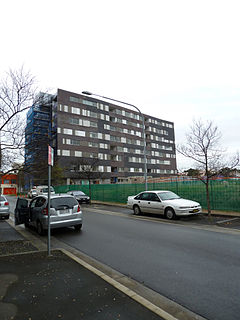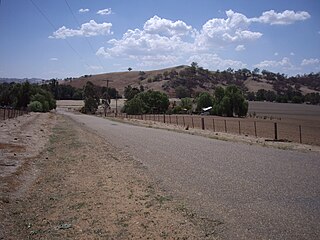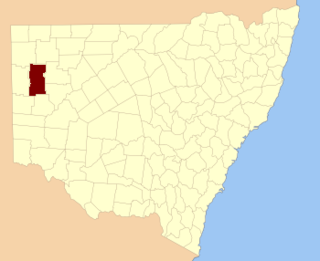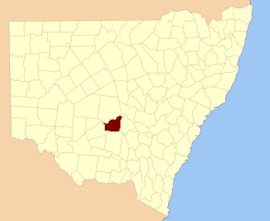
Dungog is a country town on the Williams River in the Hunter Region of New South Wales, Australia. Located in the middle of dairy and timber country, it is the centre of the Dungog Shire local government area and at the 2016 census it had a population of 2,025 people. The area includes the Fosterton Loop, 22 kilometres (14 mi) of road, used in the annual Pedalfest. A small portion of Dungog lies in the Mid-Coast Council LGA.

The South Creek or Wianamatta, a creek that is part of the Hawkesbury-Nepean catchment, is located on the Cumberland Plain, also referred to as Greater Western Sydney, New South Wales, Australia.

Zetland is an inner-eastern suburb of Sydney, New South Wales, Australia 4 kilometres south of the Sydney central business district, in the local government area of the City of Sydney.
The Geographical Names Board of New South Wales, a statutory authority of the Land and Property Information division, Department of Finance and Services in the Government of New South Wales, is the official body for naming and recording details of places and geographical names in the state of New South Wales, Australia.

Darbalara is a rural community on the east bank of the junction of the Murrumbidgee River and Tumut River in the Riverina. It is situated by road, about 25 kilometres north east of Gundagai and 25 kilometres south of Coolac.

Gloucester County was one of the original Nineteen Counties in New South Wales, and is now one of the 141 cadastral divisions of New South Wales. It includes the area around Port Stephens. It is bounded on the north and west by the Manning River, and on the south-west by the Williams River.

St Vincent County was one of the original Nineteen Counties in New South Wales and is now one of the 141 Cadastral divisions of New South Wales. It included the south coast area encompassing Batemans Bay, Ulladulla, Jervis Bay and inland to Braidwood. The Shoalhaven River is the boundary to the north and west, and the Deua River the boundary to the south.

Cowper County, New South Wales is one of the 141 Cadastral divisions of New South Wales.

Mootwingee County, New South Wales is one of the 141 Cadastral divisions of New South Wales.
Redfern was an electoral district of the Legislative Assembly in the Australian state of New South Wales, created in 1880, and named after and including the Sydney suburb of Redfern. It extended to Botany Bay and was bordered by Rainbow Street (Randwick), Anzac Parade, the southern edge of Moore Park, South Dowling Street, Cleveland Street, City Road, King Street (Newtown), Alexandra Canal and Cooks River. It elected two members from 1880 to 1882, three members from 1882 to 1887 and four members from 1887 until the abolition of multi-member electorates in 1894, when it was split into Redfern, Botany, Darlington, Waterloo and part of Newtown-Erskine. In 1920, with the introduction of proportional representation, it was absorbed into Botany. It was recreated in 1927 and abolished in 1968.
Sydney-Cook was an electoral district of the Legislative Assembly in the Australian state of New South Wales, created in 1894 in inner Sydney from part of the electoral district of South Sydney and named after James Cook. It was in the Surry Hills area, bounded by Elizabeth Street, Foveaux Street, Riley Street, Tudor Street, Davies Street, Nobbs Street, South Dowling Street, and Cleveland Street. It was abolished in 1904 and partly replaced by Surry Hills.
Sydney-Flinders was an electoral district of the Legislative Assembly in the Australian state of New South Wales, created in 1894 in inner Sydney from part of the electoral district of South Sydney and named after maritime explorer Matthew Flinders. It was in the Surry Hills area, bounded by Riley Street, Oxford Street, South Dowling Street, Nobbs Street, Davies Street and Tudor Street. It was abolished in 1904 and absorbed into the electoral district of Surry Hills.

Dowling is a census-designated place (CDP) in Baltimore Township in Barry County, Michigan, United States. The population was 374 at the 2010 census.

Naradhan is a village and locality in the Central West region of New South Wales Australia. The locality is 452 kilometres (281 mi) from Sydney, the state capital. Naradhan is within the Bland Shire local government area. The village was proclaimed in 1930, and features a shop, primary school, public hall, and the now disused railway station. The town was named after Naradhan a grazing run that was in term probably named for the Wiradjuri term "ngarradan" meaning "bat".
Dowling is a ghost town in Haakon County, in the U.S. state of South Dakota.

Dowling Parish in Mouramba County, central New South Wales is a cadasteral parish of Australia. The topography of the parish is generally flat with a thin scrub forest and the main economy of the area is agriculture.

Dowling Parish in Mouramba County, central New South Wales is a cadasteral parish of Australia. The topography of the parish is generally flat with a thin scrub forest and the main economy of the area is agriculture.

Blowering, New South wales is a rural locality in the Snowy Mountains of New South wales and a civil Parish of Buccleuch County.














